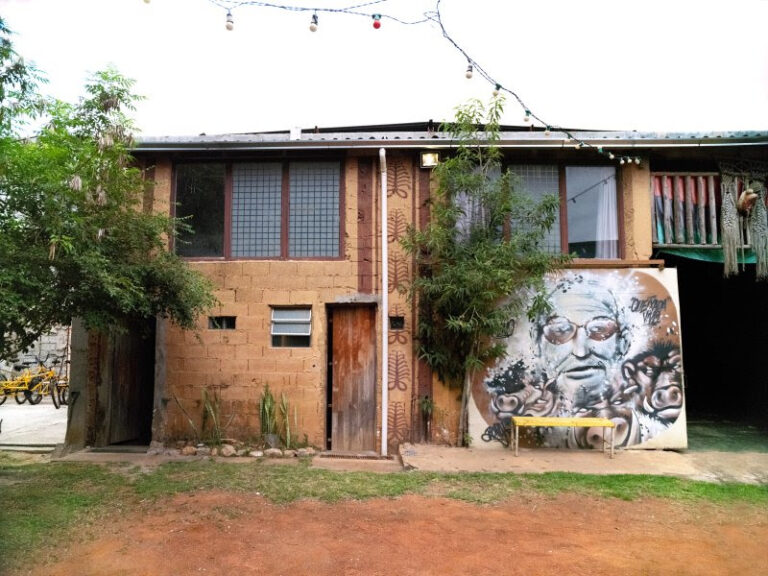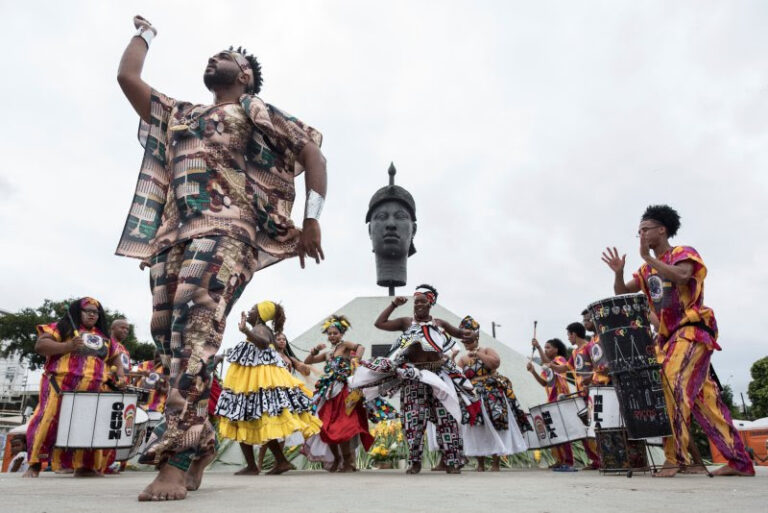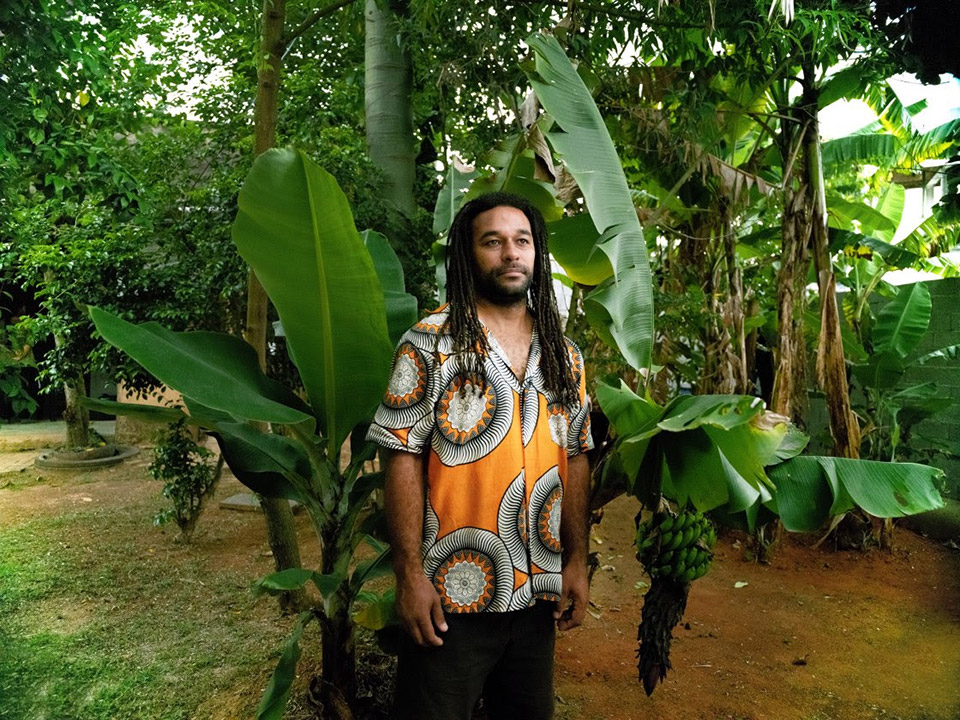By Ciara Nugent and Thaís Regina/Sāo Paulo, Brazil
A dozen people are dancing around a bonfire in a yard between two large warehouses in São Paulo. It’s early November and members of Quilombaque—a Black community hub in Perus, a poor neighborhood on the city’s northern fringes—are celebrating. They’ve raised 50% of the funds they need to buy the space they’ve occupied for the past decade and avoid eviction by the owner, who is selling up. As the fire spits embers up to a dark sky, and a steady drum beat marks out a rhythm, the group sings: “I will build my refuge, I will build my place, I will build my quilombo.”
The word quilombo–derived from languages brought to Brazil by enslaved Africans–was the name given to rural communities established by those who escaped slavery in the centuries before Brazil abolished it in 1888—the last country in the Americas to do so. At least 3,500 of those rural quilombos still exist. But today, quilombo is taking on a wider meaning. Young Black Brazilians say they need to form new communities of Black resistance to deal with a society still shaped at every level by the legacy of slavery.
Racial tensions in Brazil were inflamed by the 2018 election of far-right president Jair Bolsonaro, who on the campaign trail compared Black quilombo members to cattle and said “they don’t even serve to procreate.” But the president is just the tip of the iceberg when it comes to Brazil’s systemic racism. Around 56% of Brazilians identify as Black—the largest population of African descent outside of Africa—yet Black people make up just 18% of congress, 4.7% of executives in Brazil’s 500 largest companies, 75% of murder victims and 75% of those killed by police.
Things are getting worse. During the COVID-19 pandemic, Black Brazilians, who already earn just 57% of what white Brazilians do on average, have died and lost their jobs at a higher rate. Police killings rose to 5,804 in 2019—almost six times more than comparative figures for the U.S. Bolsonaro pushed forward an anti-crime bill last year that included a blanket “self-defense” justification for the use of force by police; the congress passed it with some limitations in December 2019, though critics still say it grants officers significant impunity. Activists and academics have accused the Brazilian state of employing a “death policy” against the Black population.
But on Nov. 20, Vice President Hamilton Mourão claimed that “racism doesn’t exist in Brazil.” He was responding to protests over the brutal beating and killing of João Freitas, an unarmed Black man, by security guards at a grocery store in the city of Porto Alegre, which was captured on security cameras. For his part, President Bolsonaro said social justice groups protesting over racism were “attempting to bring tensions into our country that are foreign to our history.”
In an era of overt racial injustice ignored by those in power, Black Brazilians are creating spaces that explicitly celebrate Black identity and power their resistance to racism. Black people in cities are forming urban quilombos, while others are pushing to aquilombar—the word’s verb form – on social media and in art and literature. Black political activists have discussed forming a quilombo in congress. “Our main goal is to fight the genocide of the Black population,” says Clébio Ferreira, 36, who founded Quilombaque with his brother in 2005 in response to poverty and violence faced by Black youth in Perus, where he has lived most of his life. “When we build a quilombo, we are coming together to build a new world.”

The Bolsonaro Administration’s denial of racism in Brazil has historical roots. As Brazil emerged from the slavery era in the 1900s, elites in the country promoted an idea of the country as a “racial democracy”—a supposedly harmonious mixing of Indigenous, white European, and Black African cultures. But at the same time, politicians, the media and academics also encouraged the descendants of enslaved Africans and indigenous communities to marry and have children with the descendants of white colonizers, as well as an influx of European immigrants, in order to produce increasingly lighter-skinned generations and “whiten” the country. Some conservative Brazilians still idealize their country as a racial democracy, where racial discrimination or conflict cannot exist.
Now, Black Brazilians are increasingly looking to another aspect of history for lessons on how to deal with a racist country. Of the 5 million enslaved Africans brought to Brazil, tens of thousands managed to flee plantations. They settled in rural areas, forming communities outside of white society. To describe these new settlements, they borrowed the word “quilombo” (often loosely translated as “war camp”) from Bantu languages spoken by some communities in sub-Saharan africa, says Stéfane Souto, a cultural researcher in Salvador, northern Brazil. “The word has many meanings, but basically it’s a social practice carried out by nomadic warriors; it can refer to both the warriors themselves and the territories where they meet.”

The largest quilombo in Brazil was Palmares, which existed for much of the 1600s. At its largest Palmares covered 10,000 square miles on Brazil’s northeastern coast and counted 20,000 members. Today it lends its name to the Palmares Cultural Foundation, the state-funded institution set up in 1988 to protect and support quilombo rights.
In the 1970’s, Beatriz Nascimento, an academic and influential figure in Brazil’s 20th Century Black rights movement, began to bring attention to how quilombos could serve the wider cause of anti-racism in Brazil. In articles and the 1989 documentary Ori, she explored the concept of the quilombo and traced the links between Black Brazilian communities and the cultural and political traditions of several African countries. “Nascimento knew that quilombos were not fixed places,” says Alex Ratts, an anthropologist and author of a biography on Nascimento. “She was the one who widened the meaning of the term quilombo. In her thinking, there could be quilombos in literature, in history—even a person could be a quilombo.” Today, 25 years after her death, her work is seeing renewed interest from a younger generation. “When people read her work now, they say “that’s what we need to do,” in a country like this, we need to aquilombar,” Ratts says. “It’s not a conversation from people in rural quilombos. It’s a very urban thing, a very contemporary political movement.”
Bianca Santana, a São Paulo-based writer and activist , says the “intensification of the racial conflict” in Brazil has spurred the growth of that movement. “We’re seeing a proliferation of aquilombamentos—in favelas, in universities, in literary movements, in hip hop—because the Black community needs to reorganize,” she says.
In August, Tamara Franklin, a 29 year-old musician based in Minas Gerais state, released an album titled Escape roots for aquilombamento. Franklin says she only recently began to learn about the history of Black people who escaped slavery to form quilombos, and read a lot about them during a COVID-19 lockdown in her home state of Minas Gerais. “When I look at the situation of Black people in Brazil today, I see that escape is still necessary. We still need to flee from these territories, which aren’t always physical, sometimes they’re economic, political, social.”
For her generation, she says, quilombo means “a place where we can meet with our equals and look after each other. Even if it’s not a physical territory.” Art and music about aquilombamento, cultural and political activism workshops, and connection on social media can provide that space, she says.

Urban quilombos, physical spaces for the Black communities to gather for cultural, educational and political activities, have also sprung up around Brazil, primarily in Black-majority favela neighborhoods on the outskirts of cities like Rio de Janeiro and São Paulo.
Ferreira says creating São Paulo’s Quilombaque was a way to fight back against the negative image of Blackness that Brazilian society’s historic preference for “whitening” has fostered. When Quilombaque began, he says, Perus didn’t have any cultural spaces. He started putting on drumming sessions and other cultural events like capoeira and art classes. Now, Quilombaque runs a community library and a tourism agency to stimulate the local economy. Since the outbreak of COVID-19, cultural events have been suspended and the center has focused on preparing food baskets for families affected by the pandemic. “The questions we’re working on here are: How can we make a person see themself as Black and have pride in being Black? How can we build that self esteem so a Black person doesn’t lower their head when they pass police officers?”
While a modern concept of the quilombo is growing, the rural communities that inspired it are under attack. Jacira Oliveira, 48, lives in the Galvão quilombo, just a few miles from Bolsonaro’s hometown of Eldorado, in São Paulo state. Having been born there herself, Oliveria has raised six children in the quilombo and serves on the community’s coordinating committee. Founded in the 1830s, beside the Pilões river, Galvão has faced many of the same challenges as other quilombos: state neglect of its infrastructure, high poverty rates and disputes with farmers who attempt to take over their land. In 1982, Oliveria’s cousin was shot dead during one such dispute. Things have improved in recent decades, though, she says. Brazil’s 1988 constitution allowed quilombos to obtain legal rights to their land. Soon after, government bodies were set up to protect and assist quilombos, including the national Palmares Cultural Foundation and a section of São Paulo state’s land agency. In the 2000s, leftist governments introduced social programs that helped support many of the communities.
Today much of that progress is under threat. Oliveira is haunted by Bolsonaro’s words in a campaign speech in Rio de Janeiro in 2017. “I’ve been to a quilombo,” he said. “The lightest afrodescendent there weighed 7 arrobas [a Brazilian measure used for cattle]. They don’t do anything. They don’t even serve to procreate any more.” He added that he would cut funding and land rights for quilombo communities if elected. “His words opened a wound, and it still hasn’t healed,” Oliveira says. “They keep trying to take away our rights, but we’re digging in our heels.”
In 2019, the president installed Sergio Camargo—an outspoken opponent of social justice groups who denies the existence of structural racism —as the head of the Palmares Cultural Foundation. He has dramatically slowed the speed at which the state is granting official recognition to quilombo communities, according to advocates. In July 2020, Bolsonaro vetoed sections of a law that would have required the state to provide emergency financial support to quilombos and Indigenous communities during the pandemic. In September, the government gutted 2021 budgets at the land agency that deals with disputes over territory, slashing 90% of funds for the department responsible for recognizing and compensating quilombos. According to local media, two thirds of the agency’s total budget are now allocated for compensating farmers—a key support base for the president.
“We’re seeing everything we worked for, everything we’ve achieved, undone,” says Selma Dealdina, executive secretary of CONAQ, a national nonprofit representing the vast majority of Brazil’s rural quilombos. While she recognizes the shared fight of all Black anti-racist activists in Brazil, Dealdina cautions that the urban movement celebrating quilombos needs to make sure it also works for the rights and prosperity of rural quilombo communities, and doesn’t just appropriate the term. “Are you actually trying to support quilombos? Buying food from quilombo communities? Reading books by quilombo authors? For me, to aquilombar has to mean helping others. Otherwise, it’s just a trend.”
The moment of more “explicit, naked, crude” racism Brazil is passing through is not a surprise to Black communities, Dealdina says. “We’ve always known it was there. A Black person in this country can’t have a moment of rest, you’ve got to keep your eyes open 25 hours a day,” she says. It won’t change the nature of quilombos, though, which are playing the role they have for centuries, she adds. “We’ll be here resisting, whether in the cities or the countryside. Quilombos are resilience itself.”
The feet of Gabriela, Jacira Oliveria’s niece, in the backyard of her aunt’s house in the Galvão quilombo in São Paulo in Oct. 2019.
The feet of Gabriela, Jacira Oliveria’s niece, in the backyard of her aunt’s house in the Galvão quilombo in São Paulo in Oct. 2019.
For Santana, the writer and activist, Bolsonaro’s election in October 2018 was part of a backlash against advances made not just by quilombos but by Brazil’s entire Black population as a result of social programs and affirmative action policies introduced by lefist governments throughout the 2000s—including racial quotas for university entrance and state jobs. “Before, when Black people didn’t have access to the same rights as white people, Brazil could pretend not to be a racist country through the myth of racial democracy,” she says. “Now, voting for someone who is racist, misogynistic, homophobic, who praises torture and the military regime, suggests many Brazilians are trying to put things back the way they think they ought to be: Black people in subaltern positions.”
Quilombos may help to power an anti-racist political response to the current moment. At Brazil’s municipal elections, political activist group Quilombo Periferico (“quilombo from the outskirts”) ran a collective candidacy of several members for São Paulo’s city council, securing a seat for local campaigner Elaine Mineiro. “Aquilombamento in politics means coming together to defend the rights of Black people, poor people, LGBTQ people—to demand new policy, and affirmative actions that are necessary if you’re going to be anti-racist,” Mineiro says.
Mineiro’s grandfather grew up in a traditional quilombo. She says it’s crucial that Black activists in both cities and rural areas put the history of those communities at the center of their political movements, because Brazilian education and media have tended to erase it in favour of the myth of racial democracy. “They have tried to take our past from us, and the past is where you look to learn,” she says. “It’s extremely important for people to be able to understand why things are the way they are. To understand that society as it is now wasn’t born, it was built. And if it was built it can be rebuilt.”





